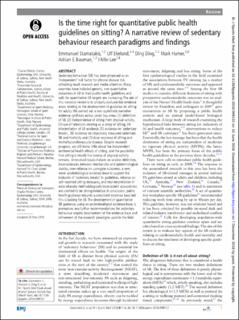| dc.description.abstract | Sedentary behaviour (SB) has been proposed as an ‘independent’ risk factor for chronic disease risk, attracting much research and media attention. Many countries have included generic, non-quantitative reductions in SB in their public health guidelines and calls for quantitative SB targets are increasing. The aim of this narrative review is to critically evaluate key evidence areas relating to the development of guidance on sitting for adults. We carried out a non-systematic narrative evidence synthesis across seven key areas: (1) definition of SB, (2) independence of sitting from physical activity, (3) use of television viewing as a proxy of sitting, (4) interpretation of SB evidence, (5) evidence on ‘sedentary breaks’, (6) evidence on objectively measured sedentary SB and mortality and (7) dose response of sitting and mortality/cardiovascular disease. Despite research progress, we still know little about the independent detrimental health effects of sitting, and the possibility that sitting is mostly the inverse of physical activity remains. Unresolved issues include an unclear definition, inconsistencies between mechanistic and epidemiological studies, over-reliance on surrogate outcomes, a very weak epidemiological evidence base to support the inclusion of ‘sedentary breaks’ in guidelines, reliance on self-reported sitting measures, and misinterpretation of data whereby methodologically inconsistent associations are claimed to be strong evidence. In conclusion, public health guidance requires a consistent evidence base but this is lacking for SB. The development of quantitative SB guidance, using an underdeveloped evidence base, is premature; any further recommendations for sedentary behaviour require development of the evidence base and refinement of the research paradigms used in the field. | |
